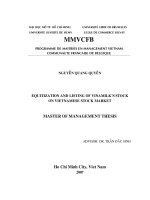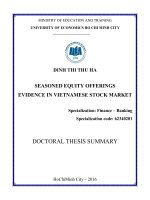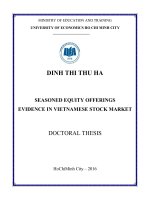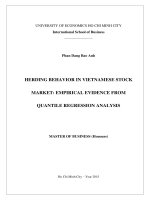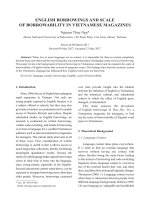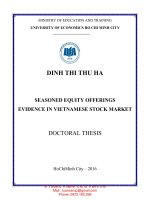Equitization and listing of vinamilk in Vietnamese stock market
Bạn đang xem bản rút gọn của tài liệu. Xem và tải ngay bản đầy đủ của tài liệu tại đây (235.6 KB, 35 trang )
ĐẠI HỌC MỞ TP. HỒ CHÍ MINH
UNIVERSITE OUVERTE DE HCMV
UNIVERSITÉ LIBRE DE BRUXELLES
ECOLE DE COMMERCE SOLVAY
MMVCFB
PROGRAMME DE MAITRIES EN MANAGEMENT VIETNAM
COMMUNAUTE FRANCAISE DE BELGIQUE
NGUYỄN QUANG QUYỀN
EQUITIZATION AND LISTING OF VINAMILK’S STOCK
ON VIETNAMESE STOCK MARKET
MASTER OF MANAGEMENT THESIS
ADVISOR: DR. TRẦN ĐẮC SINH
Ho Chi Minh City, Viet Nam
2007
2
TABLE OF CONTENT
ABBREVIATION 4
LIST OF TABLES AND CHARTS 4
FOREWORDS 5
CHAPTER 1: VINAMILK’S EQUITIZATION 8
1.1 Fundamentals of equitization 8
1.1.1 Concept of SOE equitization 8
1.1.2 The necessity and indispensability of equitization 8
1.1.3 Role of equitization in the economic integration 9
1.2 Vinamilk’s Equitization 9
1.2.1 Vietnam Government’s policy of SOE equitization 9
1.2.2 Legal environment 10
1.2.3 Vinamilk’s Equitization 10
Conclusion 1 13
CHAPTER 2: VINAMILK’S LISTING IN THE SECURITIES MARKET 14
2.1 Vietnam Securities Market’s Overview 14
2.1.1 Vietnam Securities Market 14
2.1.2 Assessments of the securities market 16
2.2 Listing targets 17
2.3 Benefits from listing 18
2.3.1 State’s benifit 18
2.3.2 Benefits of employees and shareholders 18
2.4 Process of equitization and listing in the securities market 19
2.5 Company’s achievements after equitization and listing 20
2.5.1 Business activities 20
2.5.2 Vinamilk’s shares in the securities market 21
2.6 Vinamilk’s impacts to the securities market 22
2.6.1 Psychological effect to investors 22
2.6.2 Pioneer in share auction through the securities market 22
2.6.3 Double the market size 22
2.6.4 Positive impact on equitization process and listing of other businesses 23
2.7 Vinamilk’s experiences on equitization and listing 23
2.7.1 Setting up overall and detail plans for equitization and listing 23
2.7.2 Making presentation to employees and investors about the Company’s
direction 23
3
2.7.3 Selecting the consultancy firm 23
2.7.4 Deciding the timing for equitization and listing 24
Conclusion 2 25
CHAPTER 3: VINAMILK’S DEVELOPMENT STRATEGIES AFTER
LISTING AND SOME PROPOSALS 26
3.1 Government Strategies on SOE equitization and development of Vietnam
Securities market 26
3.2 Vinamilk’s development strategies 26
3.2.1 Business 26
3.2.2 Finance 29
3.3 Policy proposals on equitization and business operation after listing 30
3.3.1 Solving the benefit conflicts between the Board and the shareholder 30
3.3.2 Reducing the State’s share ownership 31
3.3.3 Increasing the ownership of foreigners and strategic shareholders 31
3.3.4 Restructuring the company management model 32
3.3.5 Taxation policy 33
Final Conclusion 34
LIST OF REFERENCE 35
4
ABBREVIATION
SOE(s): State-owned enterprise(s)
STC(s): Securities Trading Center(s)
SSC: State Securities Commission
WTO: The World Trade Organization
APEC: Asia-Pacific Economic Co-operation
LIST OF TABLES AND CHARTS
Chart 1: Chartered Capital Structure ………………………………… 13
Chart 2: Total Sales for period 1999 – 2007 20
Chart 3: Total Domestic Sales for period 1999 – 2007 20
Chart 4: Total Net incomes for period 1999 – 2007 20
Chart 5: VNIndex and trading volume for 18 months (Jul 05 – Dec 06) 21
Table 1: Securities market highlights for period 2000-2005 ……………………. 15
Table 2: Summary of state income from Vinamilk’s equitization 18
5
FOREWORDS
Vietnam economic transformation to the market economy from the central
planned economy has been conducted on various areas step-by-step and in a
practical way in order to strike for the end of building up a State with “rich
people, strong nation, democratic and civilized society”. The two decades of
renovation has brought about to Vietnam a number of prominent achievements in
policy-making as well as implementing right solutions relevant to the Vietnam’s
specific economic characteristics.
The restructuring in state-owned enterprise (SOE) sector during the last
time has not only realized the objective that “SOE equitization must not become
SOE privatization” but has created also a new vitality to the economy with an
average growth rate of 7.5 percent per annum, streamlining the number of SOEs
to 2,000 by August 2006 from previous 12,300, increasing the average size of an
SOE from 3.3 billion VND to 22 billion VND etc… This proves that the Party and
the government’s guidelines and polices are right and profound. In addition, the
SOE equitization has made up a strong base for the establishment and
development of Vietnam securities market. And in turn, in the securities market,
Vietnam in general and enterprises in particular will be able to mobilize fund
from the domestic and the foreign investors with the highest volume at quickest
time and cheapest cost.
In order to performing the policy of SOE renovation and restructuring,
Vinamilk equitized itself at the end 2003. Though it faced a lot of difficulties
during the equitization such as the legal procedures, the business revaluation
etc…, the case was seen as a success and was set an example and basis for
Vietnam to speed up the equitization in general corporations and big state-owned
banks. This proclaims the SOE renovation and restructuring, with Vinamilk as a
6
typification, a lucid policy in the cause of national industrialization and
modernization as well as integrating into the world’s economy. As such, with the
purpose of giving more information to the public on the benefits of the
equitzation and then listing in the securities market, I would like to choose the
topic of “Vinamilk’s equitization and listing in the securities market” as my
study for the final essay in a wish that this may somehow contribute to fostering
those processes in Vietnam. Though having gone through a long road for more
than 10 years, the equitization as well as the listing in the securities market are
still practical and topical questions and are being studied by various authors.
The essay was prepared in the context of economic renovation when
Vietnam has just achieved important economic and diplomatic success in
domestic as well as in international arena. Vietnam has officially admitted as the
WTO’s 150
th
member, hosted successfully APEC 14 Summit and is the only
Asia’s candidate for the non permanent member at the United Nation.
By choosing this topic, I would like to assess the effectiveness of the
equitization and listing in the securities market by the SOEs through the typical
case of Vinamilk. Then, I would like to propose proper solutions to promote
those processes in SOEs in the coming years.
Due to the short time of studying while this topic is quite extensive and
new to Vietnam’s economy, I would like to focus on analyzing the effectiveness
from Vinamilk’s equitization and listing in the securities market in a effort to
give an unbiased view over the company’s success when implementing the Party
and the government’s policy.
To reach the end goal of the essay, I have used different methodologies
for studying and collecting the data such as synthetization, comparison, statistics,
assessment and analysis etc… As one of the members responsible for the
7
equitization and listing for Vinamilk, I used all the data practically, adequately
and correctly. Moreover, the secondary data were also gathered in order to
make the essay more vivid.
Beside the forewords, conclusion, table of contents, list of reference, the
main content in the essay are as following:
Chapter 1: Vinamilk’s Equitization
Chapter 2: Vinamilk’s listing in the securities market
Chapter 3: Vinamilk’s development Strategies after listing and some Proposals
8
CHAPTER 1
VINAMILK EQUITIZATION
1.1 Fundamentals of equitization
1.1.1 Concept of SOE equitization
The transfer of ownership in SOEs to the business individuals and private
entities is defined as the privatization in other countries, however, it is called the
equitization in Vietnam. Practically, the concept of equitization still implies the
state’s role because even when the SOEs are equitized, the state is still holding a
certain part, and in some case, a crucial part in the equitized companies. Thus,
the state-owned capital is not absolutely withdrawn and the investment role
played by the government is still there.
After more than 10 years of implementation of both pilot program as well
as expanding the equitization on a large scale, that concept has gradually been
elaborated in order to correctly capture the practices in Vietnam. Recently, the
Central Party’s 3
rd
Resolution of the IXth Session has reviewed it as follows: The
SOE equitization is a process of changing a business from one stakeholder which
is the government into a multi-shareholder business with the majority of
shareholders are the employees and private individuals. Obviously, this definition
is more generalized and reflects correctly and adequately the nature of the SOE
equitization process during the last time.
1.1.2 The necessity and indispensability of equitization
The orientation of building a socialist economy in Vietnam based on the
state-owned and the co-operative ownership in the 80s and earlier had created a
huge number of SOEs (more than 12,300 SOEs), most of which were small size,
technologically backward and even lack of capital for operation. This situation
9
put the Party and the State under a pressure to find out a solution to restructure
the SOE system and enhance the competitiveness of the SOEs as well as
strengthen the public sector’s role in the economy. In this circumstance, the
policy of SOE equitization was enacted and implemented in Vietnam.
1.1.3 Role of equitization in the economic integration
Firstly, SOE equitization helps to foster the development of the multi-
sector economy and to socialize production. It not only reduces the state subsidy
of capital in the enterprises but also pays the way for the state to concentrate to
invest and manage in the SOEs in key sectors. Equitization will bring income to
the state budget as the number of tax payers are not cut down but increase.
Equitization will minimize the administration apparatus, avoid waste if
investment, create the transparency in the ownership, balance benefits and play
as the driven to promote social development.
Secondly, equitization helps the companies in solving the capital problem,
improving their financial capability in order to expand their production and
business. Moreover, equitization will create multi-ownership businesses which
include the state, the employees, and outside individuals and institutions.
Thirdly, the equitized companies are more dynamic and easily adapted to
the market economy, so that their production and business effectiveness are
improved.
Fourthly, equitization will bring more products to the securities market.
1.2 Vinamilk’s Equitization
1.2.1 Vietnam Government’s policy of SOE equitization
Based on the result of pilot program of equitization between 1992 and
1996, the Government promulgated the Decree No.28/ CP dated on May 7, 1996
on transferring some SOEs into the equitized companies. 2 years later, it was
10
replaced by Decree 44/CP dated on 29 June, 1998 which gave more advantages
to the equitized business as well as its employees. However, as the equitization
progress was still low and in an effort to accelerate the number of equitized
SOEs, the Prime Minister enforced the Decree 64/ND-CP dated on 19 June,
2002 on transferring the SOE into the joint stock company which replaced the
Decree 44/CP.
Up to date, the latest documents on equitization is the Decree
187/2004/NÑ-CP dated on 16 November, 2004 on transferring the SOEs into the
joint stock companies and its instruction document which is the Circular
126/2004/TT-BTC dated on 16 November, 2004. Those documents basically
solves the weak points remainning in Decree 64.
1.2.2 Legal environment
Legal basis for Vinamilk’s equitization are included as follows:
- Government’s Decree 64/2002/NÑ-CP dated on 19 June, 2002 on transferring
the SOEs into joint stock companies.
- Circular 79/2002/TT-BTC dated on 12 September, 2002 by the Ministry of
Finance on guiding the revaluation of business when transferring from SOEs
into the joint stock company.
- Government’s Decree 187/2004/NÑ-CP dated on 16 November, 2004 on
transferring the SOEs into the joint stock company.
- Circular 126/2004/TT-BTC by the Ministry of Finance on guiding the Decree
187/2004/NÑ-CP.
1.2.3 Vinamilk’s Equitization
1.2.3.1 Overview of Vinamilk
The establishment and development (before equitization)
11
The company was founded in 1976 with the orginal name as Southern
Coffee-Dairy Company (a subsidiary of General Food Directorate) and was
renamed as Vinamilk in 1992. Before equitization, Vinamilk was upon the
Ministry of Industry, specializing in dairy and dairy products processing.
Principal business activities
- Producing and trading canned milk, milk powder, cereal, pastries, fresh milk,
Soya milk, soft drinks and other dairy products,
- Trading food processing equipment, parts and accessories, materials,
chemicals and raw materials,
- Real estate trading, lease brokerage; trading in warehouses and yards;
products delivering and transporting by trucks, products handling,
- Producing, buying and selling alcohols, beers, beverages, processed foods,
teas, coffee (roasted, ground, filtered and instant),
- Producing, trading packs/bags; pack printing,
- Producing, buying and selling plastic products,
- Polyclinics.
Products and Market
Vinamilk produces more than 200 kind of products of milk and from milk.
In the domestic, Vinamilk’s market share is in the lead, occupying about 35% -
75%, based on the kind of products. However, 90% of Vinamilk revenue come
from Middle East and the rest are Cambodia, American and Australia… The
export revenue is about 100 – 140 million USD per year.
1.2.3.2 Equitization content
Targets
- Transferring the business from single ownership into multi-ownership;
- Collecting money (budget) for the government;
12
- Creating opportunity to companies to mobilize the fund as well as driven for
them to do effective business;
- Lessening the company’s dependence on government.
- Creating opportunity to employees to own the company’s shares, increasing
their income and duties;
- Attracting intelligence and technology from strategic shareholders;
- Creates the goods for stock market.
Equitization form
Basis on the feature and fact, Vinamilk decided to equitize and sell a part
of state capital in the company to investors according to article 3, Decree No
64/2002/NÑ-CP dated 19/06/2002 of the government about transferring the
company to joint stock company.
Beneficiary and buying share conditions
Under the approval by the Ministry of Industry, the company sold 20 per cent
of its shares to its employees, milk cow farmer (the supplier) and outside
investors (at equitization) at price as regulated by the related legal document.
The capital structure after equitization as:
Chart 1: Chartered Capital Structure
(At equitization)
Staffs, 12.54%
Famers, 2.66%
Others, 4.80%
State, 80.00%
Source: Vinamilk
13
Valuation
Valuation method
The company used assets valuation method for tangilbe and intangible
assets (the trade mark).
After finishing equitization process, the company was tranfered to joint
stock company based on Decision No. 155/2003 QÑ-BCN dated 01/10/2003 on
the transfer of state owned company to joint stock company.
Conclusion 1
From the practical demand during the economic renovation, the
equitization policy was introduced and has been implemented in a large scale for
more than 10 years. As a production business subject to equitization, Vinamilk
took the initiative to equitize itself in order to follow up with the Party and the
Government’s policy, be self controlled and strengthen its production capacity
and competitiveness at the threshold of the economic integration. The
equitization result at Vinamilk were highly appreciated by the State and the
Government. Vinamilk was the 1st equitized SOE whose capital is over 1,000
billion VND. It is asserted that Vinamilk equitization has contributed to getting
the equitization more speedy in the following years.
14
CHAPTER 2
VINAMILK’ LISTING IN
THE SECURITIES MARKET
2.1 Vietnam Securities Market’s Overview
2.1.1 Vietnam Securities Market
2.1.1.1 During 2000-2005
With only 2 listing companies at the launch date on 28 July, 2000, the
Hochiminh City Securities Trading Center (HOSTC) has hosted for 35 kinds of
shares and 1 unit trust by the end of 2005 with the total par value (exclusive of
unit trust) of nearly 2,000 billion VND and the market value of 7,500 billion
VND. Except the year 2003 when the total market value was shrunk, the market
capitalization grew by 60 per cent year-on-year.
For bond market, beyond the expectation of the market regulator, bond
trading was “frozen” for a long time. Only after the trading mechanism for bond
were changed, together with the securities businesses began their repurchase
transaction for bonds (repos) did bond trading activities become more exciting. In
the last 2 year of 2004 and 2005, the bond trading value at the HOSTC was 41.7
trillion VND with the average of over 80 billion VND per session.
Together with the securities market coming into operation, the financial
intermediary institutions was also set up and developed. By the end of 2005,
there were 18 custodians, 13 brokerage houses and a designated settlement
bank. The number of investors also increased to 31,300 accounts in 2005 from
just nearly 3,000 in the very first year. In addition to the local investors, the
foreigner trading is considered to play a crucial role in accelerating the market
trading scale. The limit on foreign ownership was raised from an initial 20 per
cent to 30 per cent and has now been raised to 49 per cent for industrial
15
companies (however, the limit on ownership of financial sector remains at 30 per
cent). However, the equity market capitalization was quite small, making up
made up less than 1 per cent of the GDP in 2005.
Table 1: Securities market highlights for period of 2000 - 2005
Year Index
high
Index
low
Index
closing
Index
average
Market
capitalization
(bil. VND)
Market
cap./Listing
value (times)
2000 206.83 100 206.83 140.62 1,046 3.26
2001 571.04 203.12 235.4 312.85 1,605 3.32
2002 231.7 174.62 183.33 193.15 2,539 2.54
2003 183.41 130.9 166.94 152.88 2,408 2.17
2004 279.71 169.19 239.29 238.45 3,913 2.93
2005 322.59 232.41 307.5 262.3 7,511 3.88
Source: The HOSTC
2.1.1.2 In 2006
The securities market experienced a robust growth in 2006, beginning
with the listing of Vinamilk which then followed by some big companies like
Vinh Son – Song Hinh Hydropower joint stock company, Sai Gon Thuong Tin
Commercial Joint Stock Bank, corporate bonds of Vietcombank and BIDV etc…
At the end of 2006, there were 106 listed companies at the HOSTC with the total
listed par value of over 14 trillion VND and their market capitalization of 145,5
trillion VND. Besides, there were 2 securities investment funds which listed its
fund certificates in the market with the listed par value of 1 trillion VND. In bond
market, the listed value (including the government and corporate bonds) at the
HOSTC in 2006 was 57.51 trillion VND. In addition, the mobilizing fund in 2006
was totally 1.361 trillion dong, 3 times higher than that in 2005. Beside that, the
shares prices were moved positively during this period. The index closed at
751.77 points, up more than 444 points or 2.5 times from the previous year.
16
The total trading volume in this year were 643.3 million shares and unit
trusts, equivalent to 38,175 trillion VND, up by 5 times in volume and 12 times in
value compared to the previous year. On average, 2.57 million shares and unit
trust were executed every day which resulted in a daily trading value of 152.7
billion VND. However, if bonds were counted in, the daily trading turnover
would be 4.4 million securities, and worth 340 billion VND in 2006. The trading
accounts at the brokerage houses in 2006 were around 107,000, 3 times higher
than those in the previous year, 98 per cent out of which were the individual
accounts, and there were over 1,300 foreign account (up 4 times compared to
those in 2005).
2.1.2 Assessments of the securities market
2.1.2.1 During 2000 – 2005
- This is the establishment period: The key elements were being set up and put
into operation. The market was still small and the growth rate was very low.
- Many joint stock companies were still reluctant to list shares in the stock
market due to the complicated disclosure requirements. Moreover, the
market’s role in mobilizing fund for business was not utilized and exploited.
- The demand was limited due to the lack of awareness of the securities market
by the investors.
- The SOE equitization was not strongly progressed and did not go in parallel
with the listing in the stock market, which resulted in the shortage in the
“supply”.
2.1.2.2 In 2006
The market capitalization in 2006 was equivalent to 22 per cent of the
GDP. This strong growth might be subject to the following reasons:
17
- The strong determination by the government to to push forward the
equitization in big SOEs in order to create the supply to the stock market.
- The world leading financial groups such as MerryLynch, Citigroup, HSBC…
have continuously issued good reports on Vietnam’s good investment
environment and economic development potential.
- The government is considering to reduce the State’s stake in equitizing SOEs
and just hold their ownership in some important sectors with an aim to bring
about the actual self-control to the businesses and lessen the subsidizing
burden from the state budget.
- The Securities Law would become effective in 2007 that drew much attention
from the investors.
- Most of the listing companies were doing their business quite well and
profitable.
- The Ministry of Finance decreed that those who would be listed after
December 31, 2006 would no longer be enjoyed income tax holiday which
created a wave of new listing during the year.
- etc.
2.2 Listing targets
Value added for the company and for the shareholders
The company’s market value is increased and as a result, the ownership
value by each shareholder is increased, too. Beside that, company’s name or
brand is advertised without charges on various means of mass media and
communications which means that the company can save a big budget for
advertising.
Increase of share liquidity
Shares can be exchanged easily through stock market.
18
Raising fund
Vinamilk itself is setting up strategies to make full use of the opportunities
of raising fund from the market.
Providing products for Vietnam’s stock market
With 159 million shares, Vinamilk were estimated to double the listing
volume at the end of 2005 and with the expected price of 50,000 dong, the
market value would also be multiplied by twice.
2.3 Benefits from listing
2.3.1 State’s benifit
From Vinamilk’s equitization, out of the company’s the chartered capital
of 1.590 billion VND, the State collected back totally 1,920.3 billion VND while
its stake at the business remained 50.01% after its listing.
Table 2: State’s income from Vinamilk equitization
Item Amount (billion VND)
Chartered capital 1,590
Asset revaluation (value added) 105.4
1
st
auction: Selling out 20% 292
2
nd
auction: Selling out 15% 710.4
3
rd
auction: Selling out 10.46% 812.5
Total 1,920.3
2.3.2 Benefits of employees and shareholders
Basically, the workforce at the business are not cut down but increase with
new recruitments thanks to the growth and development of the business after
19
being restructured. Moreover, most of the employees are shareholders so that
when the business is profitable, their shares or assets are valued higher.
2.4 Process of equitization and listing in the securities market
- On 1
st
October, 2003, the Ministry of Industry issued the Decision No.
155/2003/QÑ-BCN on transferring Vinamilk into a joint stock company.
- On 18
th
October, 2003, Vinamilk’s IPO was organized, the state’s ownership
after IPO was 80 percent. During this IPO, the average offering price was
15,450 VND/share, the income for the state budget was 292 billion dong.
- On 1
st
December, 2003, Vinamilk was licensed with the Business Register
Certificate.
- On 28
th
February, 2005, the second auction offering additionally 15 percent of
the state’s ownership in Vinamilk was organized. This auction was organized
through the HOSTC with the average price of 31,300 VND/share, taking back
to the state budget 710,4 billion dong. The success beyond expectation of this
auction commenced the pubic offerings at the equitizing SOEs through the
securities trading centers.
- On 29
th
November, 2005, Vinamilk held the 3
rd
auction additionally offering
10.49 percent of the state ownership over the company’s capital.; The
average offering price was 48,874 VND/share, taking back to the state budget
812.5 billion dong.
- On 28
th
December, 2005, the State Securities Commission issued listing
license to Vinamilk;
- On 19
th
January, 2006, Vinamilk’s shares coded as VNM was officially traded
on Vietnam’s securities market.
20
2.5 Company’s achievements after equitization and listing
2.5.1 Business activities
-
1,000
2,000
3,000
4,000
5,000
6,000
7,000
8,000
(Bil VND)
1999 2000 2001 2002 2003 2004 2005 2006E 2007F
Chart 2: Total Sales
Source: Vinamilk
After equitization, Vinamilk totally changed from a 100 percent state
owned enterprise into operating as a multi-ownership business. The revenue
grows at 12.2% - 49,4% per year, with the domestic revenue of 17.2% -
32.8%/year on average during 2004-2006. Especially, when the exporting market
suffered difficulties during 2003 – 2004, the company focused on expanding its
domestic market share which resulted in the high increase in this revenue.
-
1,000
2,000
3,000
4,000
5,000
6,000
7,000
(Bil VN)
1999 2000 2001 2002 2003 2004 2005 2006E 2007F
Chart 3: Total Dome s tic Sales
-
100
200
300
400
500
600
700
800
900
1,000
(Bil VND)
1999 2000 2001 2002 2003 2004 2005 2006E 2007F
Cha rt 4 : Total net incom es
Source: Vinamilk
21
In addition, the company also concentrated on the management
accounting. As a result, the input costs are systematically and effectively
controlled and the after tax profit keeps on increase year on year. The net profit
on revenue ratio is maintained at 10% - 12%. The net profit over the equity is
25% - 34% and the dividend on par value is 15% - 18%/year.
2.5.2 Vinamilk’s shares in the secur7market
Vinamilk shares (VNM) doubled the listing volume and capitalization at its
listing date. As at end of 2006, VNM remained among the market “blue chips”
with the trading price of 125,000 dong (2.5 times higher than its first trading day
price and 7.72 times higher than its book value) and the market capitalization of
19,875 billion dong (equivalent to 1.24 billion USD) which occupied
approximately 14 per cent of the total capitalization of equity. Foreign ownership
in VNM increased to 39.4 per cent at the end of 2006 from the previous 28.7 per
cent at the listing date. And in fact, the market was going through a boom in term
of the share volume
and the trading
turnover shortly after
VNM came to the
game. VNIndex
constantly went up
and closed the year
2006 at 751,77 points
which was 2.5 times
higher than the year
beginning.
Chart 5: VNIndex and trading volume for 18 months (Jul 05 - Dec 06)
0
1,000,000
2,000,000
3,000,000
4,000,000
5,000,000
6,000,000
7,000,000
8,000,000
Shares
100
200
300
400
500
600
700
800
900
Points
Source: The HOSTC
22
2.6 Vinamilk’s impacts to the securities market
2.6.1 Psychological effect to investors
The local and foreign investors had been very interested in the event of
Vinamilk equitization. Therefore, the company’ success in equitization had a
good impression on the business circle in general and for the investors in
particular. This represents as a solid evidence to the Vietnam’s economic reform
and open policy in order to integrate into the world’s economy as well as the
success of SOEs restructuring program. To the domestic businesses, Vinamilk
presents a typical case for them to follow when equitizing and listing.
2.6.2 Pioneer in share auction through the securities market
Vinamilk was the first business that conducted share auction through the
HOSTC. Though being the vanguard, the auctions to sell state owned shares to
the public were successful out of expectation and the last price was 5 times
higher than the par value. The company set a typical precedent for other
following businesses to do the auctions at the securities trading centers, solving
the situation of organizing the auction interally within the businesses that had lots
of negative practices. Up to date, most of initial public offerings or additional
issues through the stock market has been conducted successfully and has brought
about enormous benefits to the state.
2.6.3 Double the market size
As Vinamilk came to the game, the total listed volume as well as the
market value was doubled which was seen as a breakthrough to the stock market.
Additionally, the huge number of Vinamilk’s shareholders were becoming the
market investors which then helped to increase the trading accounts as well as to
attract more newcomers to the market.
23
Also, Vinamilk was the first equitizing SOE whose capital is over 1 trillion
dong to be listed in the securities market, making the commencement for other
big companies to follow. This is seen as a positive factor to the upward change in
VNIndex for the following months.
2.6.4 Positive impact on equitization process and listing of other businesses
The success of Vinamilk has encouraged the equitization in other SOEs.
There have been more and more companies conducting the open auctions at the
securities trading centers. The listing companies at the end of 2006 were triples
than the previous year.
2.7 Vinamilk’s experiences on equitization and listing
2.7.1 Setting up overall and detail plans for equitization and listing
The success of Vinamilk is partly attributed to the planning phrase. By
setting up an overall and detail plan, the company’s Board would have a
panorama on the project at its start, and this would help the all necessary works
to be implemented by the project team professionally and effectively.
2.7.2 Making presentation to employees and investors about the Company’s
direction
Before equitization, the company should have a workshop or seminar to
present the employees and investors about its plan and direction after
equitization. As long as they understand it, the company’s plan for equitization
and listing can be implemented quickly, favorably and more effectively.
2.7.3 Selecting the consultancy firm
Consultancy firm plays an important role in the process of equitization and
listing. It is the intermediary between the issuer and the investors. Furthermore,
with the professional services conducted by the consultancy firm, the company’s
24
value would be enhanced and as a result, the equitization and listing are more
successful.
2.7.4 Deciding the timing for equitization and listing
Vinamilk was equitized in the context that the equitization policy had
been introduced but was implemented very slowly and the Government was
trying to speed up this process by diffent ways; the legal documents for the SOE
restructuring was amended and added, typically the Decree No 187/CP on
changing the SOEs into the joint stock companies. Vinamilk leaped at the
opportunity to advertise for the company’s image by deciding to be the first who
carried out the share auction through the stock market.
As soon as completing the equitization, the company immediately
prepared all the documentation and procedures for listing in the stock market.
Though the market was then in its fifth year of operation, there was still and
always lack of trading products and how to provide the market with more supply
was a critical problem to the regulators. In the context that the Government was
targeting to expand the securities market, and the economy was growing at a
high and stable rate, Vinamilk decided to officially list its shares in January,
2006, right after the people had just enjoyed the Traditional New Year. It was
because of “a united people, favorable terrain and a clement weather” that
helped VNM take a good start at listing and be highly welcomed by the domestic
and foreign investors, paving the way for the sharp increase of new products to
the stock market in 2006.
25
Conclusion 2
Listing in the stock market was the next target clearly set out by the
Company’s Board of Management right after completing the equitization. The
carefully preparation as well as the implementing timing was seen as key factors
to its success. Vinamilk is always among the “blue-chips” and occupies a large
proportion in the market trading turnover.
For the company, the production and business activities have been
maintained and improved after equitization and listing. Business strategies were
formed and have been executed in an effort to prove to investors and
shareholders of a good and profitable business which is crucial to keep the
company’s images. It can be concluded that Vinamilk’s listing, in some extent,
contributed to develop the stock market and at the same time, the stock market is
offering practical benefits which the company is seeking for itself and for its
shareholders.


